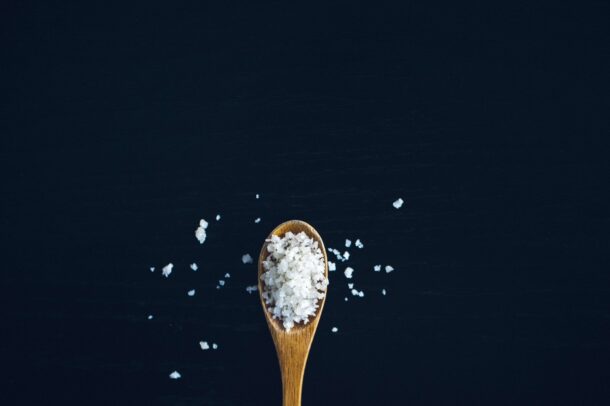Written by Fiona Bellefeuille RD, CDE
Photo by Jason Tuinstra on Unsplash
You have probably heard that having too much salt can be harmful to your kidneys, but how much is too much? Salt is sodium chloride. When trying to figure out if a product is high or low in salt, reading the nutrition label can help.
Usually, excess sodium is excreted in the urine but when the kidneys are not working well, this can lead to sodium build-up in the body, causing high blood pressure, swelling, protein leaking into the urine and blood acidity.
The minimum recommended intake for the general population for sodium is 1,500 mg per day. Current kidney guidelines recommend aiming for a sodium intake of less than 2,300 mg per day. To protect your kidneys, keep your sodium intake to between 1,500 mg and 2,300 mg per day unless otherwise instructed by your healthcare team. Always consult with your healthcare team and dietitian for your own personal requirements.
Nutrition Facts
The nutrition facts table on food products provides information about the amount of sodium in the product. The table displays both the amount of sodium in milligrams (mg) and the percentage of your daily value (% daily value). The % daily value tells you the percentage of your daily allowance of the nutrient contained in a serving of the product. Always remember to look at the serving size to see if this is the size that you are consuming. For example, if the serving size is 1 cup of soup but you only have ½ cup you can half the nutritional information as you are only eating half of the serving. Remember the serving size is only a suggested size, it does not mean you have to eat that amount. Follow the three steps below to help choose low sodium products and avoid high in sodium ones.

Added salt and seasoned sauces are usually high in sodium. One teaspoon of salt has 2,300 mg of sodium. One tablespoon of soy sauce has 1,000 mg of sodium. Using the nutritional facts table can help you to limit your sodium intake by purchasing lower-sodium products and avoiding high-sodium products. Limiting your sodium intake can help you to manage kidney disease.
Nutrition claims
Another way to find out if a food product is low in sodium is to see if there is a nutrition claim. Food companies are permitted to display nutrition claims on their products if they meet the requirements set out by the government. It is important to know what these claims mean so that you can make low sodium choices at the store. This table tells you what the claims mean and what to be aware of.
| The Claim Says: | This means: | Be Aware |
| Salt Free | The product contains less than 5 mg of sodium per serving | * Keep to the serving size listed |
| Low Sodium / Salt | The product contains 140 mg or less of sodium per serving | * Keep to the serving size listed |
| Lower or Reduced Salt / Sodium | The product contains at least 25% less sodium than the food it is compared to | * This product may still be high in sodium |
| Lightly Salted | The product contains at least 50% less sodium than the food it is compared to | * This product may still be high in sodium |
| No added salt | The product contains no added salt | * There may still be some natural sodium in this product |
Following a low-sodium diet can help you to manage your kidney disease, taking time to read the nutrition facts and nutrition claims will help you to follow a low-sodium diet.
